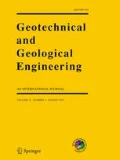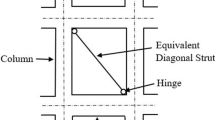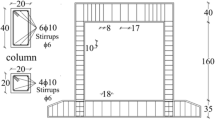Abstract
This paper presents a method to evaluate reliability for internal stability of reinforced soil structures using reliability based design optimization. Using limit equilibrium method and assuming the failure surface to be logarithmic spiral, analysis is conducted to maintain internal stability against both tensile and pullout failure of the reinforcements. Properties of backfill soil and strength of the geosynthetic reinforcement are considered as random variables. For the seismic conditions, reliability indices of all the geosynthetic layers in relation to tension and pullout failure modes are determined for different magnitudes of seismic accelerations both in the horizontal and vertical directions, surcharge load and design strength of the reinforcement. The efforts have been made to obtain the number of layers, pullout length and total length of the reinforcement at each level for the desired target reliability index values against tension and pullout modes of failure. The influence of horizontal and vertical earthquake acceleration, surcharge load, design strength of the reinforcement, coefficient of variation of soil friction angle and design strength of the reinforcement on number of layers, pullout length and total length of the reinforcement needed for the stability at each level is discussed.














Similar content being viewed by others
Abbreviations
- F :
-
resultant force acting along the radial line of the logarithmic spiral
- FS it :
-
factor of safety with respect to tension failure at each level
- FS ipo :
-
factor of safety with respect to pullout failure at each level
- f X (x):
-
is a joint probability density function of X
- g :
-
acceleration due to gravity
- g(.):
-
limit state function
- H :
-
height of reinforced soil structure (=ar 0)
- k h , k v :
-
horizontal and vertical seismic acceleration coefficients
- K :
-
reinforcement force coefficient needed to maintain the stability
- L g :
-
length of the failure zone of reinforced soil at the top of wall
- L a :
-
active reinforcement length
- L ei :
-
pullout length of reinforcement
- L t :
-
total length of the reinforcement required to stabilize the wall
- P ri :
-
pullout force on the embedded reinforcement length of each layer
- q :
-
surcharge intensity
- Q :
-
surcharge coefficient (=2q/γH)
- \( Q_{{h\_SH_{1} G}} \) :
-
horizontal inertial force acting on the wedge SH 1 G
- Q h_q :
-
horizontal inertial force due to surcharge load (q)
- \( Q_{{v\_SH_{1} G}} \) :
-
vertical inertial force acting on the wedge SH 1 G
- Q v_q :
-
vertical inertial force due to surcharge load (q)
- r 0, r 1 :
-
initial and final radius of the log-spiral wedge (AH 1 G)
- r :
-
average radius of the elemental strip in the log-spiral wedge (H 1 JG)
- T r :
-
reinforcement force needed to maintain the stability
- T max :
-
tensile strength required at each level of reinforcement
- T imax :
-
tensile strength required at each level of reinforcement
- T u :
-
design strength of the reinforcement
- u i :
-
variables in standard normal space
- \( W_{{AH_{1} EK}} \) :
-
weight of triangular wedge AH 1 EK
- W ESG :
-
weight of triangular wedge ESG
- W KEGC :
-
weight of triangular wedge KEGC
- W AGC :
-
weight of triangular wedge AGC
- \( W_{{AH_{1} EK}} \) :
-
weight of triangular wedge AH 1 EK
- \( X = \left\{ {x_{i} } \right\}_{i = 1}^{n} \) :
-
vector of random variables representing uncertain quantities
- \( U = \left\{ {u_{k} } \right\}_{k = 1}^{n} \) :
-
vector of standard random variables representing uncertain quantities
- \( \beta_{t} \,{\text{and}}\,\beta_{ipo} \) :
-
reliability indices against tension, pullout mode at each level of reinforcement
- z :
-
depth of reinforcement layer under consideration
- σ vi :
-
effective vertical stress acting on the embedded reinforcement length
- γ :
-
unit weight of the backfill
- ϕ :
-
friction angle of the backfill
- θ 1 :
-
subtended angle of log-spiral wedge (AH 1 G)
- θ 2 :
-
angle of the initial radius of the log-spiral wedge (AH 1) with horizontal
- θ :
-
angle of the radial line of elemental strip with initial radius of the log-spiral wedge
- δ :
-
soil-reinforcement interface friction angle
- b :
-
\( \cos \theta_{2} - e^{{\theta_{1} \tan \phi }} \cos \left( {\theta_{1} + \theta_{2} } \right) \)
- a :
-
\( \left[ {e^{{\theta_{1} \tan \phi }} \sin \left( {\theta_{1} + \theta_{2} } \right) - \sin \theta_{2} } \right] \)
References
Babu GLS, Basha BM (2008a) Optimum design of cantilever sheet pile walls in sandy soils using inverse reliability approach. Comput Geotech 35(2):134–143. doi:10.1016/j.compgeo.2007.04.001
Babu GLS, Basha BM (2008b) Optimum design of cantilever retaining walls using target reliability approach. Int J Geomech 8(4):240–252. doi:10.1061/(ASCE)1532-3641(2008)8:4(240)
Basha BM, Babu GLS (2008) Target reliability based design optimization of anchored cantilever sheet pile walls. Can Geotech J 45(4):535–548. doi:10.1139/T08-004
Basha BM, Babu GLS (2009) Seismic reliability assessment of external stability of reinforced soil walls using pseudo-dynamic method. Geosynth Int 16(3):197–215
Basha BM, Babu GLS (2010a) Optimum design for external seismic stability of geosynthetic reinforced soil walls: A reliability based approach. J Geotech Geoenviron Eng ASCE 136(6):797–812
Basha BM, Babu GLS (2010b) Reliability assessment of internal stability of reinforced soil structures: A pseudo-dynamic approach. Soil Dyn Earthq Eng 30(5):336–353
Basma AA, Barakat SA, Omar MT (2003) Reliability based risk index for the design of reinforced earth structures. Geotech Geol Eng 21:225–242. doi:10.1023/A:1024932408001
Bathurst RJ, Cai Z (1995) Pseudo-static seismic analysis of geosynthetic reinforced segmental retaining walls. Geosynth Int 2(5):787–830
Chalermyanont T, Benson C (2004) Reliability-based design for internal stability of mechanically stabilized earth walls. J Geotech Geoenviron Engnrg ASCE 130(2):163–173. doi:10.1061/(ASCE)1090-0241(2004)130:2(163)
Duncan J (2000) Factors of safety and reliability in geotechnical engineering. J Geotech Geoenviron Eng ASCE 126(4):307–316. doi:10.1061/(ASCE)1090-0241(2000)126:4(307)
FHWA (2001) Mechanically stabilized earth walls and reinforced soil slopes: design and construction guidelines, Publication FHWA NHI-00-43. Federal Highway Administration and National Highway Institute, Washington, DC
Kramer SL (2003) Geotechnical earthquake engineering. Prentice-Hall, Upper Saddle River
Leshchinsky D, Boedeker RH (1989) Geosynthetic reinforced soil structures. J Geotech Eng 115(10):1459–1478
Leshchinsky D, Kaching S (1994) Pseudo-static seismic stability of slopes. J Geotech Eng 120(9):1514–1532. doi:10.1061/(ASCE)0733-9410(1994)120:9(1514)
Ling HI, Leshchinsky D (1998) Effects of vertical acceleration on seismic design of geosynthetics reinforced soil structures. Geotechnique 48(3):347–373
Ling HI, Leshchinsky D (2005) Failure analysis of modular-block reinforced soil walls during earthquakes. J Perform Construct Facilit ASCE 19(2):117–123
Ling HI, Leshchinsky D, Perry EB (1997) Seismic design and performance of geosynthetic reinforced soil structures. Geotechnique 47(5):933–952
Nimbalkar SS, Choudhury D, Mandal JN (2006) Seismic stability of reinforced-soil wall by pseudo-dynamic method. Geosynthetics Int 13(3):111–119. doi:10.1680/gein.2006.13.3.111
Nouri H, Fakher A, Jones CJFP (2008) Evaluating the effects of the magnitude and amplification of pseudo-static acceleration on reinforced soil slopes and walls using the limit equilibrium horizontal slices method. Geotex Geomem 26(3):263–278. doi:10.1016/j.geotexmem.2007.09.002
Phoon K, Kulhawy F (1999) Evaluation of geotechnical property variability. Can Geotech J 36:625–639. doi:10.1139/cgj-36-4-625
Saran S, Garg KG, Bhandari RK (1992) Retaining wall with reinforced cohesionless backfill. J Geotech Eng 118(12):1869–1888. doi:10.1061/(ASCE)0733-9410(1992)118:12(1869)
Sawada T, Chen WF, Nomachi SG (1993) Assessment of seismic displacements of slopes. Soil Dyn Earthq Eng 12(3):357–362. doi:10.1016/0267-7261(93)90038-S
Sayed S, Dodagoudar GR, Rajagopal K (2008) Reliability analysis of reinforced soil walls under static and seismic forces. Geosynth Int 15(4):246–257. doi:10.1680/gein.2008.15.4.246
The MathWorks Inc (2007) Optimization toolbox user’s guide. MATLAB Programming
Zornberg JG, Sitar N, Mitchel JK (1998) Performance of geosynthetic reinforced slopes at failure. J Geotech Geoenviron Eng 124(8):670–683. doi:10.1061/(ASCE)1090-0241(1998)124:8(670)
Author information
Authors and Affiliations
Corresponding author
Rights and permissions
About this article
Cite this article
Basha, B.M., Babu, G.L.S. Reliability Based Earthquake Resistant Design for Internal Stability of Reinforced Soil Structures. Geotech Geol Eng 29, 803–820 (2011). https://doi.org/10.1007/s10706-011-9418-9
Received:
Accepted:
Published:
Issue Date:
DOI: https://doi.org/10.1007/s10706-011-9418-9




